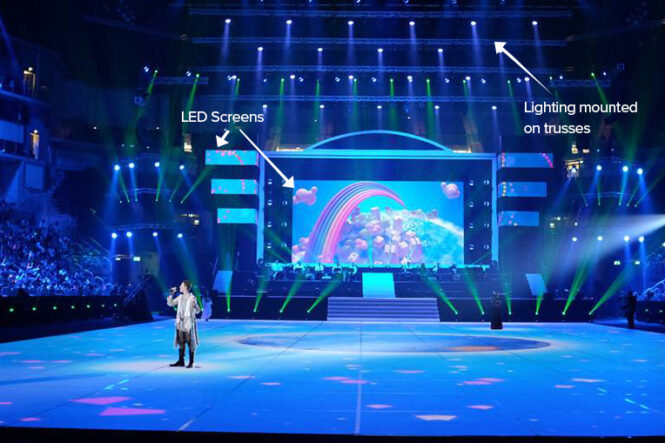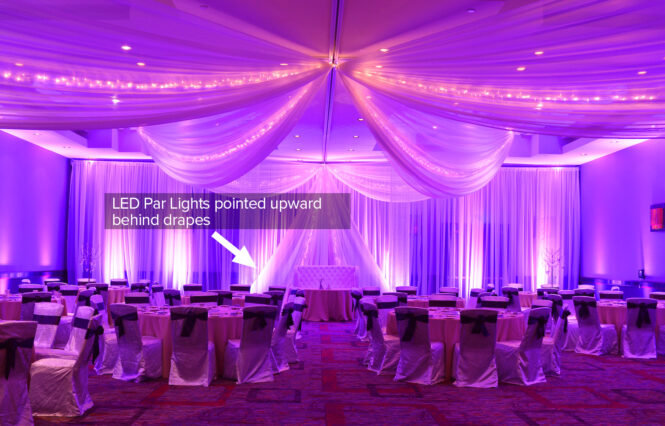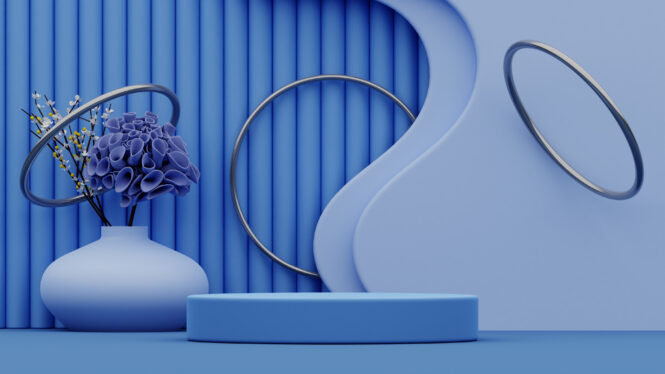A well-designed stage can help your event stand out from the crowd. A sharp stage can elevate the look of an event venue while also ensuring both the presenters and audience members are immersed in the experience.
Fortunately, dressing up your stage doesn’t necessarily require a big budget or access to specialty equipment. By incorporating simple production elements like a digital screen, lighting, a backdrop, and a few props, event planners can easily raise the quality of their stages and their events.
Ready for some tips on how to incorporate each of these stage design elements? We’ll show you how to create these effects on your own, along with an advanced option for each tip if you’re ready to truly elevate your event.
Digital screens
Gone are the days of hanging up an event poster or banner and calling it a day. Now, technology is a large part of modern events and should be a big consideration during your design process.
Wide digital screens are commonly used to display multimedia content such as videos, product previews, scrolling ads, banners, and other event promotions. The content you display on a digital screen has the potential to be engaging and memorable thanks to its large visual impact.
DIY option: A 75-inch TV screen from an electronics store is a perfect event screen for beginners. If you’re running an event for less than 100 people, you’ll be surprised by how clearly everyone will be able to see the screen. You just need to run a long HDMI cable from the TV to the computer from which you’ll project the media. You can also get a wireless HDMI transmitter and receiver to avoid dealing with cables.

Advanced option: Once you’re ready to take it up a notch, you can look into LED screens/video walls, which are composed of small panels that can be patched together to make any size screen. This is similar to what you see at award shows, music concerts, and other larger-budget events. LED walls require professional assembly, and most providers will train your team on how to operate the screens.

Decorative Stage Lighting
The right lighting can provide instant pizzazz to your stage. A great lighting system can transform a plain canvas into a new environment full of energy and excitement. Lighting can also control the mood of the stage and make a dramatic change to a less-than-thrilling venue.
DIY option: LED PAR lights are an inexpensive way to completely transform your stage. Place these alongside the wall pointing upwards (or within your drapes) to create a colorful glow. You’ll instantly create a professional, color-lit background. For easier lighting control, you might consider connecting lights with a DMX controller to manage them all from one place.

Advanced option: Team up with an audiovisual company for advanced options like lights that can move with music, lighting that covers the entire stage and audience, or lighting that’s controlled according to what’s happening on stage. Before getting quotes, read up on a few things you should know about hiring AV companies.
Backdrop (the “Pipe and Drape”)

A backdrop can transform a simple space like a gym into an elegant event venue. The “pipe and drape” of an event space refers to building a “false wall” to conceal part of the venue. This effect can also be used to divide up the room or give the impression that there’s a backstage area behind the presenter, even if it’s just a wall.
- DIY option: Create an easy pipe-and-drape effect with PVC pipes from your local hardware store and fabric from a crafts shop. There’s a great tutorial here that can help you recreate this effect yourself.
- Advanced option: You can hire professional backdrops from any events decor company. Here’s a great place to purchase complete backdrop packages from professionals who’ve staged events for some of the world’s biggest brands.
Props

Sometimes the best event stage design choice is to let the space speak for itself with just a few accessories. Whether it’s an interesting chandelier or hand-carved wood trim, your venue may already be doing the heavy lifting for your event stage design if you look hard enough. But, if you want to add that extra flair, here’s how props can help.
- DIY option: First, make sure your event theme is solid. Then, browse discount stores, antique shops, retail shops, and boutiques to gather and collect the right kind of decor. Props should speak to the theme and can be purchased anywhere. Also, consider adding a pop-up banner, which is an inexpensive but fast way to communicate the messaging behind your event.
- Advanced option: Hire an event designer to coordinate the look and feel of your event. An event planner typically has a full inventory of props at their disposal to give your event a professional touch.
Create a Memorable Event Stage
Whether you’re an event planning pro or a total beginner, you have the power to create your own stage design. A stage is simply a blank canvas you can use to create something truly special.
Remember, you can create an awesome experience on any budget. You can always start small and develop as you go. The more events you plan, the more refined your design will become!
If you’re an event organizer, our Event Promoter bundle helps you stay organized by collecting RSVPs and payments, sending out reminders, and automating event emails. Take the stress out of your event by bundling our best-selling products so you can focus on designing an awesome event.
The post 4 Tips for Event Stage Design appeared first on The Events Calendar.
0 Commentaires